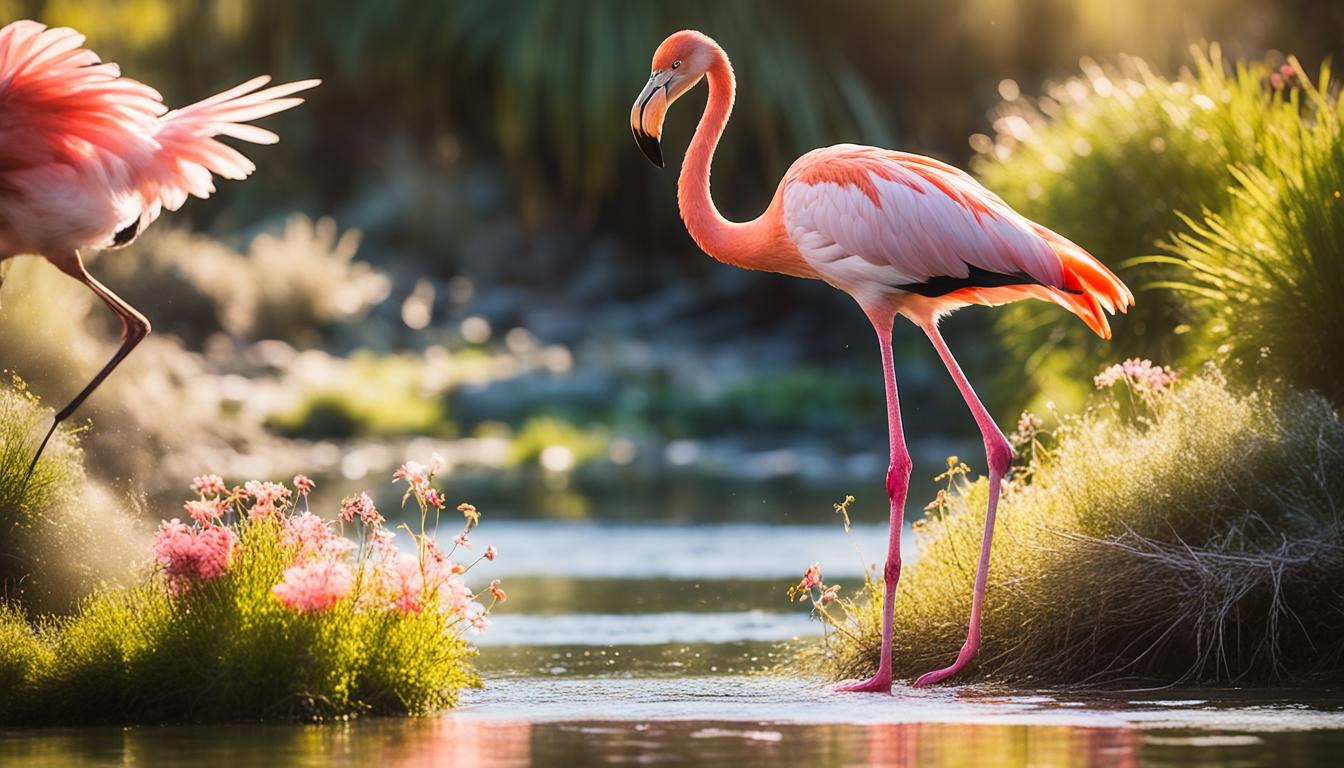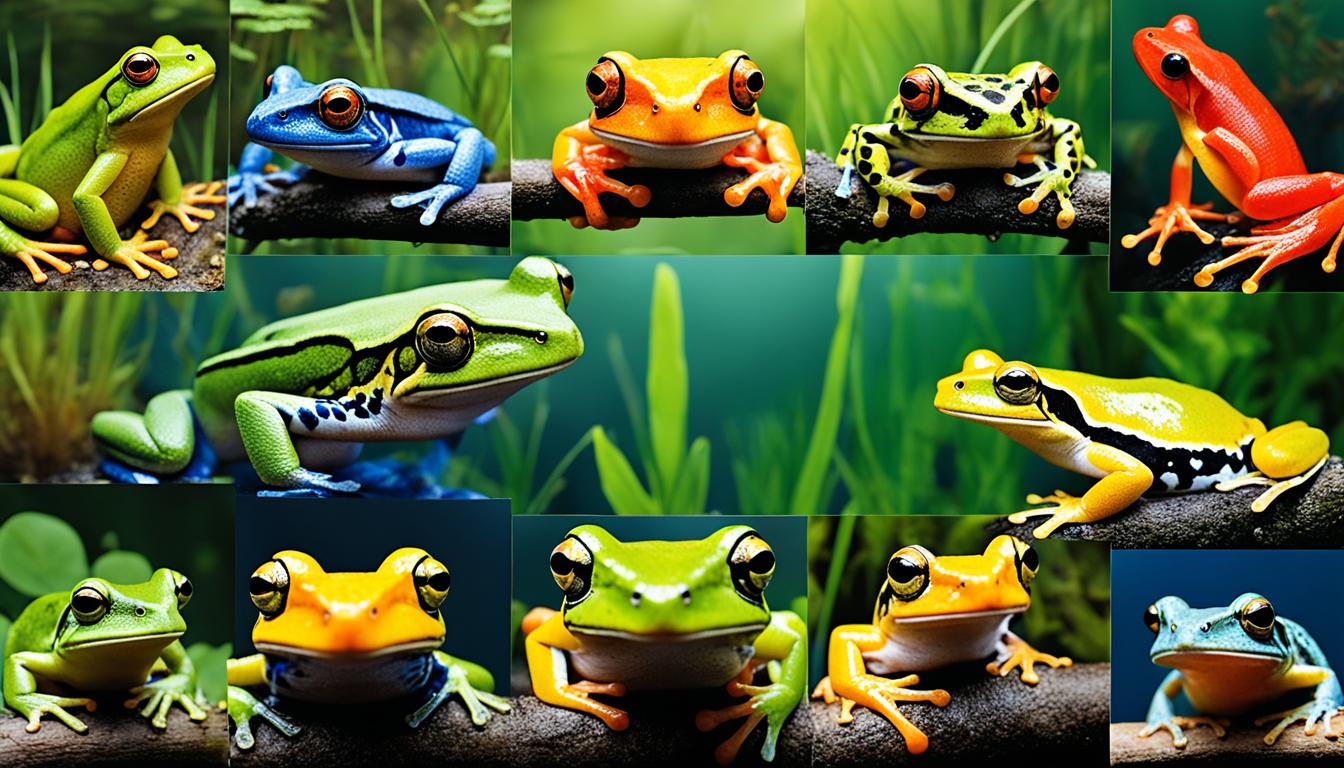Have you ever realized that the animal kingdom is filled with a remarkable variety of creatures hailing from different parts of the globe? Ranging from tiny insects to gigantic mammals, the richness of life on Earth is truly extraordinary. And when it comes to animals beginning with the letter “A,” the options are limitless!
Whether you’re fascinated by mammals, reptiles, amphibians, or birds, there are plenty of amazing animals that begin with A. From the elusive aardvark to the majestic African bush elephant, each of these creatures has its own unique characteristics and adaptations that make them truly remarkable.
So, let’s dive into the fascinating world of animals that start with A. Get ready to discover the incredible variety of species that inhabit our planet and learn more about their habitats, behaviors, and the challenges they face in the wild.
Key Takeaways:
- Animals that start with A encompass a wide range of species from different animal groups.
- From the aardvark to the African bush elephant, each animal has its own unique characteristics and adaptations.
- Exploring the animal kingdom allows us to appreciate the diversity of life on Earth and the incredible variety of creatures that inhabit our planet.
Aardvark
The aardvark, also known as Orycteropus afer, is a unique mammal native to sub-Saharan Africa. Despite its name meaning “earth pig” in Afrikaans, the aardvark is not related to pigs at all. Instead, it belongs to a group of animals known as Afrotheria, which includes elephants and manatees. This fascinating creature is known for its nocturnal habits and specialized diet.
The aardvark’s diet primarily consists of ants and termites, making it an insectivorous animal. With a long, sticky tongue and keen sense of smell, it can easily locate and capture its tiny prey. Its diet is essential for maintaining aardvarks’ unique physiology and survival in their natural habitat.
Key Facts about Aardvarks:
- Aardvarks have a sturdy build with a barrel-shaped body, strong limbs, and powerful digging claws.
- They possess a long, tubular snout and large, rabbit-like ears for enhanced senses.
- Nocturnal by nature, aardvarks spend their daylight hours sleeping in underground burrows, avoiding the blistering African sun.
- These creatures have a unique ability to close their nostrils to keep out dust and pests while digging.
- Their burrows often host other animals such as warthogs, hyenas, and porcupines once abandoned by the aardvark.
Aardvarks exhibit fascinating behaviors and remarkable adaptations that make them an intriguing animal to study. Their nocturnal lifestyle and natural digging abilities have allowed them to thrive in the challenging environment of sub-Saharan Africa.
Did You Know? In some African cultures, the aardvark is believed to possess magical qualities or be a symbol of perseverance and strength.
African Bush Elephant
The African bush elephant is the largest land animal on Earth, dominating the African savannas and forests. With a height reaching up to 4 meters at the shoulders and weighing over 10 metric tons, this magnificent creature is a true marvel of the animal kingdom. Its sheer size and power demand admiration and respect.
Unfortunately, despite its grandeur, the African bush elephant is an endangered species. Illegal poaching and habitat loss have taken a severe toll on their population. These gentle giants, once roaming freely across the African continent, are now fighting for survival.
It is our responsibility to protect and conserve these majestic animals for future generations.
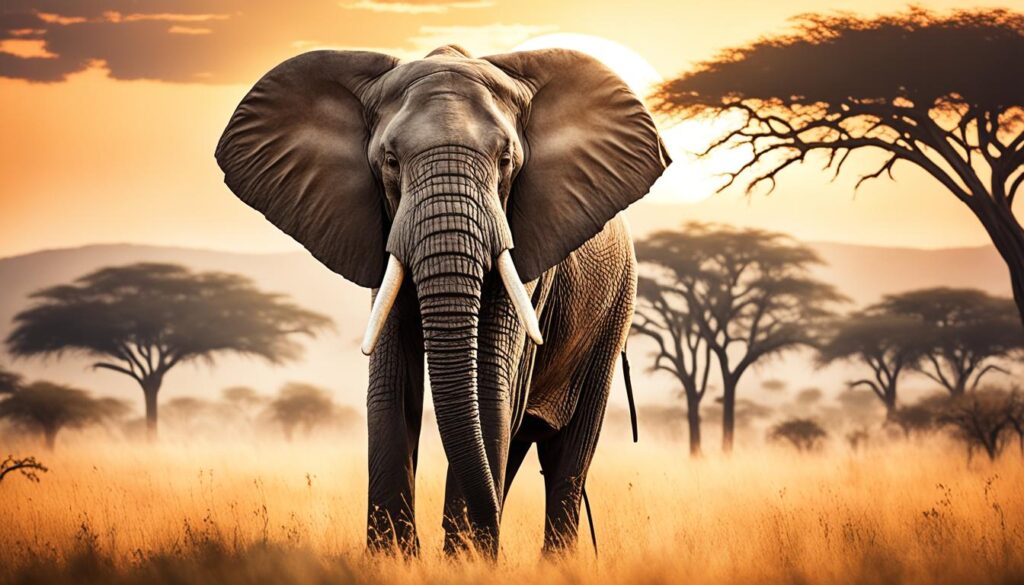
“The African bush elephant is not only the largest land mammal but also a keystone species in many ecosystems. Their presence helps maintain the balance of the environment, shaping the landscapes they inhabit.”
African Bush Elephant Facts:
- The African bush elephant is known for its distinctive large ears, which help regulate its body temperature.
- They have a highly developed sense of smell and can communicate over long distances using infrasound.
- Elephants are social animals, living in tight-knit family groups led by a matriarch.
- These herbivores have a diet consisting mainly of grass, leaves, bark, and fruits.
- African bush elephants play a crucial role in shaping their habitats by creating water holes and clearing vegetation.
Conservation Efforts:
Efforts to protect and conserve the African bush elephant are essential to prevent their extinction. Organizations and governments are working tirelessly to combat illegal poaching, implement stricter regulations, and promote sustainable practices in elephant habitats.
It is crucial that we raise awareness about the plight of these magnificent creatures and support initiatives that aim to ensure their survival in the wild.
The Importance of African Bush Elephants:
The African bush elephant plays a vital role in maintaining the delicate balance of its ecosystem. Their feeding habits, movement patterns, and interactions with other species shape the landscapes they inhabit. By protecting the African bush elephant, we are safeguarding not only a species but also the biodiversity and long-term health of the habitats they call home.
We must act now to preserve this iconic symbol of Africa and ensure a future where these incredible animals can thrive once again.
Arctic Fox
The Arctic fox is a fascinating small fox species that inhabits the Arctic regions of the Northern Hemisphere. This agile and adaptable creature has unique adaptations that enable it to thrive in the harsh and icy environments it calls home. With its thick coat and furry paws, the Arctic fox is well-equipped to withstand the frigid temperatures of the Arctic.
One remarkable characteristic of the Arctic fox is its ability to change the color of its fur according to the season. In the summer, its fur can range from brown to gray, blending in with the tundra and rocky landscapes of its habitat. However, as winter arrives and the snow covers the ground, the Arctic fox transforms into a stunning white, camouflaging itself perfectly with the snowy surroundings.
These clever foxes have a keen sense of hearing and excellent hunting skills, which allow them to locate and capture their prey. They primarily feed on small mammals, birds, and insects, adapting their diet to the available resources in their environment.
This resourceful species has also evolved to reproduce and raise their young in the extreme Arctic conditions. Arctic foxes create underground dens, which provide protection from the harsh weather and serve as a safe haven for their pups. The female Arctic fox gives birth to a litter of about 5-9 pups, nurturing and caring for them until they are ready to explore the frozen landscapes.
| Key Facts about the Arctic Fox | |
|---|---|
| Scientific Name | Vulpes lagopus |
| Family | Canidae |
| Habitat | Arctic regions of the Northern Hemisphere |
| Adaptations | Thick fur, fuzzy paws, color-changing coat |
| Prey | Small mammals, birds, and insects |
| Lifespan | Average of 3-6 years in the wild |
| Status | Least Concern |
The Arctic fox serves as an important indicator species for the health of Arctic ecosystems. As climate change brings significant shifts to the Arctic regions, the Arctic fox and other Arctic animals face challenges to their survival. Monitoring and conserving the Arctic fox population is crucial for maintaining the delicate balance of this unique and beautiful ecosystem.
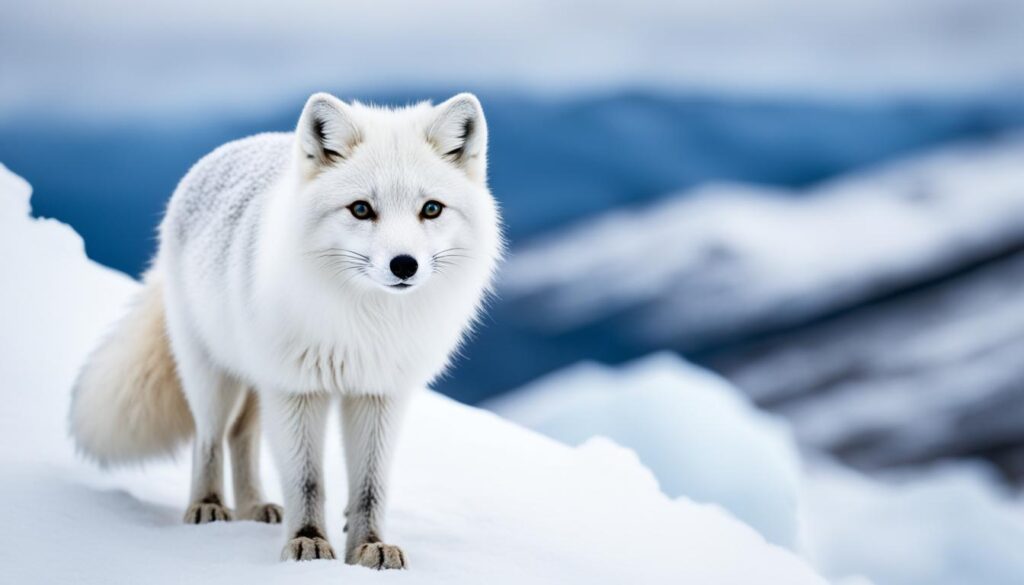
The Arctic Fox’s Survival Stories
One remarkable story of the Arctic fox’s adaptability is its ability to traverse long distances in search of food. Researchers have discovered that some Arctic foxes can travel incredible distances, reaching up to 3,500 kilometers in just a few months. These journeys showcase their incredible resilience and resourcefulness in the face of changing conditions.
Another fascinating survival technique of the Arctic fox is its ability to build up fat reserves during abundant periods. When food is scarce, these clever foxes rely on their body’s stored fat as an energy source, enabling them to survive until more food becomes available. Nature truly has its own ways of ensuring the survival of its resilient creatures.
By studying the Arctic fox and its adaptations, scientists and researchers gain valuable insights into the effects of climate change and the overall health of Arctic ecosystems. Protecting the Arctic fox means safeguarding the delicate balance of this unique and captivating habitat for generations to come.
Albatross
Albatrosses are large seabirds that can be found in various parts of the world. With their impressive wingspan and graceful flight, these seabirds are a captivating sight to behold. Albatrosses belong to the family Diomedeidae and are known for their unique courtship rituals and lifelong monogamy.
There are approximately 22 recognized species of albatross, each with its own distinct characteristics. These seabirds have adapted to life at sea, spending the majority of their lives soaring over the open ocean in search of food. Their diet primarily consists of fish, squid, and krill.
One of the most remarkable features of the albatross is its wingspan, which can reach up to 11 feet (3.4 meters) in some species. This allows them to cover vast distances while expending minimal energy. Albatrosses are renowned for their ability to fly long distances without landing, using the power of the wind to glide effortlessly through the air.

Albatrosses are highly adapted to life on the open ocean, with webbed feet that enable them to navigate the water with ease. They are skilled divers and can plunge from great heights to catch their prey beneath the surface. These seabirds also have keen eyesight, which aids them in spotting food from high above.
Unfortunately, several species of albatross are facing significant threats to their populations. Human activities, such as pollution and overfishing, have had a detrimental impact on their habitats and food sources. Additionally, albatrosses are vulnerable to becoming entangled in fishing gear, leading to accidental injuries and fatalities.
“The beauty and majesty of the albatross remind us of the wonders of the natural world and the importance of protecting these magnificent seabirds.”
| Key Features | Key Facts |
|---|---|
| Average wingspan | Approximately 11 feet (3.4 meters) |
| Habitat | Oceans and coastal regions |
| Behavior | Monogamous, lifelong mating pairs |
| Diet | Fish, squid, krill |
| Threats | Habitat loss, pollution, overfishing, bycatch |
Despite the challenges they face, efforts are being made to conserve and protect albatross populations. Conservation organizations are working to reduce bycatch in fishing operations and establish protected areas where these seabirds can thrive.
By raising awareness and implementing sustainable practices, we can ensure the survival of these magnificent albatross species and preserve the delicate balance of our marine ecosystems.
Amphibians
Amphibians are fascinating creatures that belong to a diverse group of animals including frogs, toads, and salamanders. They are known for their ability to live both on land and in water, making them true masters of adaptation. In this section, we will explore two notable amphibians that start with the letter A: the African clawed frog and the axolotl.
African Clawed Frog
The African clawed frog (Xenopus laevis) is a species native to sub-Saharan Africa. It derives its name from the sharp claws on its hind feet, which are used for digging and defense. These aquatic creatures have unique characteristics, such as their ability to breathe through their skin, which allows them to extract oxygen from the water.
The African clawed frog is also known for its fascinating reproductive methods. They exhibit a phenomenon called indeterminate growth, where they continue to grow throughout their lives. Additionally, they lay their eggs in water and do not possess a tadpole stage like most frog species. Instead, the eggs hatch into fully-formed frogs, skipping the larval stage entirely.
To better understand the African clawed frog, here are some key facts about this remarkable amphibian:
| Common Name | African Clawed Frog |
|---|---|
| Scientific Name | Xenopus laevis |
| Habitat | Sub-Saharan Africa |
| Diet | Primarily carnivorous, feeding on small invertebrates |
| Special Characteristics | Breathes through its skin, exhibits indeterminate growth, skips the tadpole stage in its life cycle |
Image:

Axolotl
The axolotl (Ambystoma mexicanum) is a unique amphibian that captures the attention of researchers and enthusiasts worldwide. Native to the ancient lakes of Xochimilco and Chalco in central Mexico, the axolotl is known for its remarkable regenerative abilities. If injured, it can regenerate lost body parts, including limbs, spinal cord, and even portions of its heart and brain.
The axolotl has a distinctive appearance, with feathery external gills and a neotenic trait, meaning it retains its juvenile features throughout its life. Unlike most amphibians that undergo metamorphosis from aquatic larvae to terrestrial adults, the axolotl remains aquatic and gilled into adulthood. This makes it a popular choice for research due to its potential impact on regenerative medicine and understanding the mechanisms behind tissue regeneration.
To learn more about the axolotl, here are some key details about this captivating creature:
| Common Name | Axolotl |
|---|---|
| Scientific Name | Ambystoma mexicanum |
| Habitat | Ancient lakes of Xochimilco and Chalco in central Mexico |
| Diet | Primarily carnivorous, feeding on small invertebrates and small fish |
| Special Characteristics | Extraordinary regenerative abilities, external gills, neotenic trait |
Through their unique characteristics and intriguing life cycles, both the African clawed frog and the axolotl showcase the amazing diversity found within the world of amphibians.
African Grey Parrot
The African grey parrot is a fascinating species known for its high level of intelligence, making it one of the most intelligent birds in the world. Found in dense forests across Africa, this parrot is highly adaptable and has the ability to mimic human speech with remarkable precision. Its affinity for mimicry has earned it the reputation of being an excellent companion and entertainer.
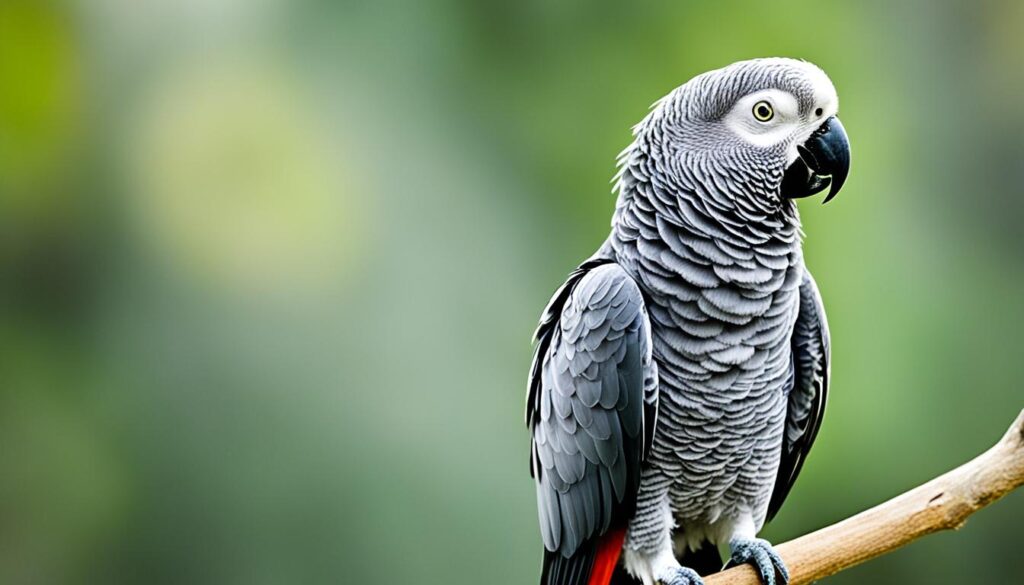
Unfortunately, the African grey parrot faces significant threats in its natural habitat. Illegal trapping for the pet trade and habitat loss have led to a sharp decline in its population, causing it to be classified as an endangered species. This is a critical concern, as the loss of these intelligent and vibrant birds would be a great loss to the natural world.
Characteristics of the African Grey Parrot
Here are some key characteristics that make the African grey parrot unique:
- Intelligence: The African grey parrot is renowned for its cognitive abilities. It has been observed to possess problem-solving skills, excellent memory, and the capacity for complex communication.
- Vocalizations: These parrots have a wide range of vocalizations and a remarkable ability to mimic human speech. They can learn and replicate not only words but also the tone and inflection with surprising accuracy.
- Feather Colors: African grey parrots have predominantly grey feathers with a striking red tail. Their plumage not only gives them a distinct appearance but also aids in their camouflage within their natural environment.
- Long Lifespan: In captivity, African grey parrots can live for several decades, with some individuals reaching the age of 50 to 60 years. This longevity underscores their exceptional adaptability and intelligence.
“The African grey parrot’s ability to mimic human speech and its level of intelligence make it a truly captivating and sought-after pet. However, it is crucial that we prioritize their conservation and protection in the wild to prevent further population decline.”
African Grey Parrot Conservation Efforts
Conservation organizations and wildlife authorities are actively working to protect the African grey parrot and its habitat. Efforts include:
- Legal Protection: Governments have implemented laws and regulations to prohibit the trapping, trading, and export of African grey parrots.
- Education and Awareness: Public awareness campaigns aim to educate communities about the importance of protecting these birds, discouraging illegal activities and promoting sustainable practices.
- Habitat Conservation: Initiatives focus on preserving and restoring the dense forests where African grey parrots thrive, ensuring the availability of suitable nesting and foraging habitats.
- Community Involvement: Local communities are encouraged to participate in conservation efforts, providing alternative livelihoods that promote sustainable practices while minimizing the economic dependency on illegal wildlife trade.
| Threats | Solutions |
|---|---|
| Illegal trapping for the pet trade | Implementation of strict laws and regulations, enforcement of trade bans, and public awareness campaigns |
| Habitat loss and deforestation | Protected area designation, reforestation projects, and sustainable land-use practices |
| Climate change | Supporting initiatives to mitigate climate change and its impact on parrot habitats |
By addressing these challenges and working together, we can ensure the long-term survival of the African grey parrot and preserve its remarkable intelligence for future generations to marvel at.
African Wild Dog
The African wild dog, also known as the painted dog, is a highly social mammal found in Africa. These magnificent creatures live and hunt in packs, showcasing remarkable teamwork and cooperation. With their unique coat patterns, they are easily identifiable in the savannah.
African wild dogs are dynamic pack hunters, relying on their incredible stamina and speed to chase down their prey. They primarily target medium-sized antelope, such as impalas and kudus. Their sharp teeth and powerful jaws make capturing and subduing their prey an efficient process.
Unfortunately, the African wild dog is classified as an endangered species. Habitat loss, due to human encroachment and land development, has severely impacted their population. Additionally, conflicts with humans, such as accidental trapping and poaching, pose significant threats to their survival.
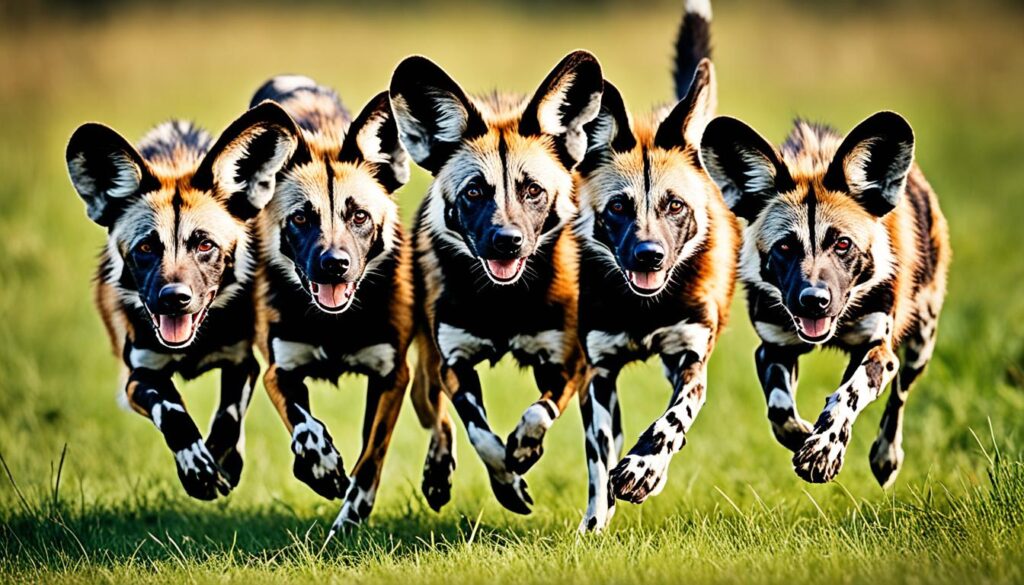
To protect and conserve these amazing animals, efforts are being made to preserve their natural habitats and implement conservation plans. Organizations such as the African Wildlife Foundation and local conservation groups work tirelessly to ensure the survival and well-being of the African wild dog.
In conclusion, the African wild dog is an extraordinary endangered species known for its pack hunting behavior and striking coat patterns. Its conservation is of utmost importance to maintain the biodiversity of African ecosystems and to preserve the natural heritage of these magnificent creatures.
Airedale Terrier
The Airedale Terrier is a versatile breed of domestic dog that originated from Yorkshire, England. These dogs are highly valued for their intelligence, loyalty, and exceptional working abilities. Originally bred to hunt badgers and other small game, Airedale Terriers have a strong prey drive and a determined nature.
With their distinctive wiry coat and sturdy build, Airedale Terriers are not only prized for their hunting skills but also make excellent companions and family pets. They are known for their playful and outgoing personalities, making them a favorite choice among families with children.
Airedale Terriers are highly intelligent and trainable, with a natural inclination towards various working roles. They have been utilized as police and military dogs, search and rescue dogs, and even as therapy dogs due to their calm and patient demeanor.
One notable characteristic of Airedale Terriers is their strong sense of loyalty towards their owners. They form strong bonds with their human family members and are known to be protective without being aggressive. Their alert and watchful nature also makes them effective watchdogs.
In addition to their working abilities and loyalty, Airedale Terriers are also renowned for their adaptability. They can thrive in various living environments, whether it be a spacious suburban home or an apartment, as long as they receive regular exercise and mental stimulation. Daily walks and playtime are essential to keep them physically and mentally satisfied.
If you’re considering adding an Airedale Terrier to your family, it’s important to note that they require consistent training, socialization, and firm leadership. While they are generally friendly towards other dogs, early socialization is essential to ensure they get along well with other pets.
Key Features of Airedale Terriers:
- Intelligent and trainable
- Loyal and protective
- Excellent working abilities
- Adaptable to different living environments
- Playful and outgoing
If you’re looking for a versatile and loyal companion who excels in various working roles, the Airedale Terrier might be the perfect breed for you.

Alaskan Malamute
The Alaskan malamute is a large, powerful breed of dog known for its ability to withstand harsh Arctic conditions. Originating from Alaska, this breed is well-suited for sled dog activities and is a true working dog. Alaskan malamutes have a strong build with a dense coat that provides insulation against the cold climate. They possess remarkable strength and endurance, allowing them to pull heavy loads over long distances.
The Alaskan malamute is closely related to the Siberian husky, another Arctic breed. However, unlike the Siberian husky, which is bred for speed, the malamute is bred for strength and stamina. These dogs have a friendly and affectionate temperament, making them excellent family pets and loyal companions.
Due to their striking appearance and unique abilities, Alaskan malamutes have gained popularity around the world. Their thick coats and alert eyes make them a visually appealing breed, while their sled dog heritage adds to their allure.

When it comes to training, Alaskan malamutes can be independent and strong-willed. Early socialization and consistent, firm training are essential for ensuring they grow into well-behaved dogs. Their intelligence and willingness to learn make them highly trainable, although they may require patience and positive reinforcement.
As with any large breed, it’s important to provide Alaskan malamutes with regular exercise and mental stimulation. Daily walks, playtime, and other activities can help keep these energetic dogs happy and healthy.
In summary, the Alaskan malamute is a remarkable breed known for its strength, endurance, and ability to thrive in Arctic conditions. Whether as a sled dog, working companion, or family pet, this breed brings loyalty, companionship, and joy to those who share their lives with these majestic dogs.
Anchovy
Anchovies are small fish that can be found in the oceans around the world. These tiny oceanic fish species play an important role in marine ecosystems as they serve as a food source for larger fish and marine animals.
Anchovies have a distinct taste and are commonly used in various cuisines. They are often salted, cured, or packed in oil to enhance their flavor and prolong their shelf life. Anchovy fillets are a popular ingredient in dishes such as Caesar salads, pasta sauces, and pizza toppings.
These small fish are known for their strong, distinct flavor, which adds depth and richness to dishes. Although some people may find the taste overpowering, anchovies can bring a unique umami flavor to a wide range of recipes.
Fun Fact: Did you know that the word “anchovy” is derived from the Spanish word “anchoa”?
Despite their size, anchovies are high in nutrients such as omega-3 fatty acids, protein, and calcium. Including anchovies in your diet can provide several health benefits, including promoting heart health and supporting bone strength.
Next time you enjoy a Caesar salad or a slice of pizza with anchovies, take a moment to appreciate the role these small fish play in both the oceanic ecosystem and the culinary world.
| Key Information | Description |
|---|---|
| Common Name | Anchovy |
| Scientific Name | Engraulidae |
| Class | Actinopterygii |
| Family | Clupeidae |
| Size | Varies between species, typically 2 to 10 inches |
| Habitat | Oceans around the world |
| Diet | Plankton, small fish, marine invertebrates |
| Status | Not threatened or endangered |
Anchovy Fillets: A Versatile Ingredient
Anchovy fillets are commonly used in various cuisines to add a burst of flavor to dishes. Here are some popular ways to use anchovy fillets:
- Mix minced anchovy fillets with garlic and olive oil to create a delicious pasta sauce.
- Add anchovy fillets to salad dressings for a savory kick.
- Spread anchovy paste on bruschetta or crostini for a flavorful appetizer.
- Combine mashed anchovy fillets with butter to make a delicious compound butter for steak or roasted vegetables.
With their unique taste and versatility, anchovy fillets can elevate the flavor of a wide variety of dishes and add a savory twist to your culinary creations.
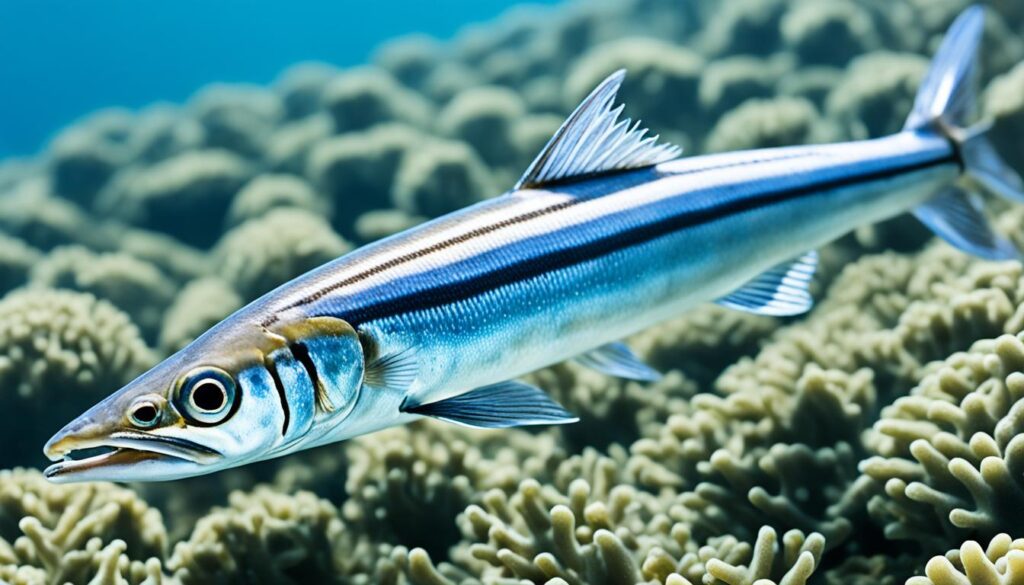
Angel Shark
The Angel Shark is a fascinating species of shark known for its distinct flat-bodied shape. These sharks are members of the Squatinidae family and are characterized by their broad pectoral fins and camouflaged appearance, allowing them to blend seamlessly into their sandy habitats.
Angel Sharks are not the traditional fast-swimming hunters like other shark species. Instead, they have adapted to a unique hunting strategy that involves lying in wait on the seafloor for their prey. Their flattened bodies and well-camouflaged skin make them virtually invisible to unsuspecting fish and other small marine animals.
Once prey comes within striking distance, the Angel Shark swiftly lunges forward, using its powerful jaws to snap up its prey. Their speedy reflexes and strong bite force make them formidable hunters in their environment.
These sharks are found in various coastal waters around the world, including the eastern Atlantic Ocean, the Mediterranean Sea, and the Pacific Ocean. They prefer sandy or muddy bottoms where they can easily bury themselves and wait for their next meal.
Angel Shark Facts:
- Angel Sharks belong to the order Squatiniformes and are not classified as true rays.
- There are approximately 24 known species of Angel Sharks.
- These sharks primarily feed on fish and crustaceans.
- Angel Sharks have been known to bury themselves in the sand, leaving only their eyes and spiracles exposed, to camouflage and ambush prey.
- They can reach lengths of up to 6.5 feet (2 meters) and can weigh up to 77 pounds (35 kilograms).
To visualize the unique flat-bodied form and camouflage of the Angel Shark, take a look at the image below:
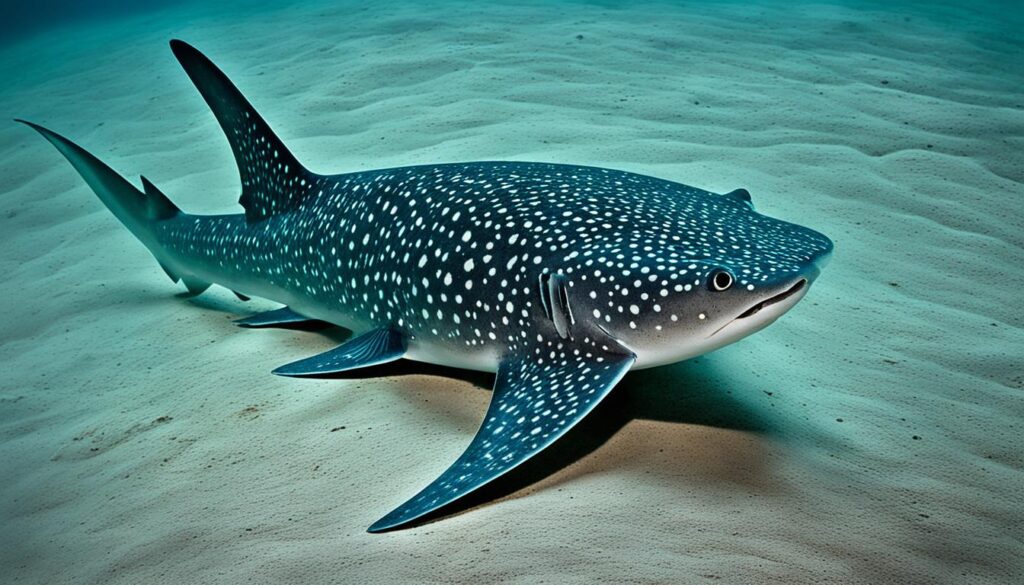
As you can see, the Angel Shark’s anatomy allows it to seamlessly blend into the sandy seafloor, making it an incredibly effective ambush predator.
Stay tuned for the next section where we will explore another fascinating creature from the animal kingdom.
Anglerfish
Anglerfish are fascinating deep-sea creatures that have captured the curiosity of scientists and nature enthusiasts alike. With their unique adaptations and hunting techniques, they are truly remarkable creatures found in the darkest and most remote parts of the ocean.
One of the most striking features of the anglerfish is the bioluminescent lure that the females possess. This specialized appendage hangs in front of their mouths, emitting a glowing light that attracts unsuspecting prey. The anglerfish uses this light as a lure, enticing smaller fish and crustaceans to come closer before striking and devouring them.
Living in the extreme depths of the ocean, anglerfish have adapted to survive under conditions of high water pressure and near-freezing temperatures. Their bodies are built to withstand these harsh environments, allowing them to thrive in the deep sea where other creatures would struggle to survive.
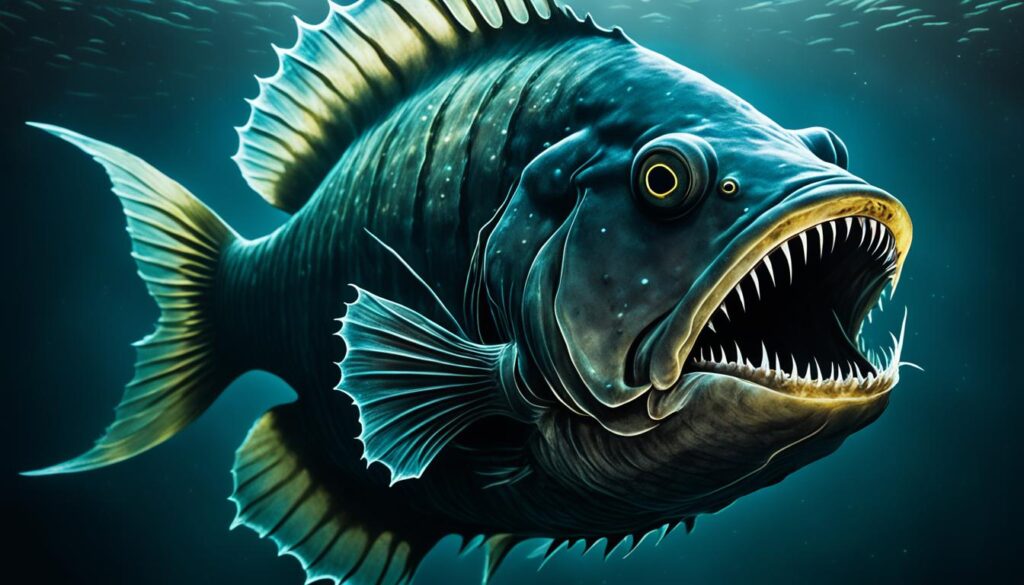
These deep-sea creatures have a unique and mysterious allure. With their large mouths filled with sharp teeth and elongated bodies, they are perfectly designed for life in the deep sea. The anglerfish is a testament to the incredible diversity of life on our planet and the vast wonders that lie beneath the surface of the ocean.
The Deep Sea: A World of Exquisite Bioluminescence
In the depths of the ocean, where sunlight cannot penetrate, bioluminescence becomes a crucial survival tool. Many deep-sea creatures, including the anglerfish, have developed the ability to produce their own light. Bioluminescence serves various purposes, from attracting prey to deterring predators and even communicating with mates.
The anglerfish’s bioluminescent lure is a perfect example of this adaptation. It not only helps the anglerfish catch its prey but also acts as a means of communication in the pitch-black waters of the deep sea. Male anglerfish, which are significantly smaller than females, use the light from the lure to locate a mate. Once found, the male anglerfish latches onto the female’s body and fuses with her, becoming a permanent parasitic mate.
| Characteristics | Description |
|---|---|
| Bioluminescent Lure | The female anglerfish has a unique appendage called the illicium, which emits a glowing light to attract prey. |
| Deep-Sea Adaptations | Anglerfish have evolved specialized adaptations to thrive in the extreme conditions of the deep sea, such as high water pressure and cold temperatures. |
| Unique Reproductive Strategy | The male anglerfish is significantly smaller than the female and fuses with her, becoming a permanent parasitic mate. |
Exploring the Deep Sea: Uncovering the Wonders of the Anglerfish
The study of deep-sea creatures like the anglerfish provides valuable insights into the biodiversity and adaptations of life on Earth. Researchers continue to explore the depths of the ocean, uncovering new species and unraveling the mysteries of this extraordinary ecosystem.
The anglerfish, with its mesmerizing bioluminescence and unique hunting techniques, reminds us of the incredible diversity that exists below the surface of the ocean. These deep-sea creatures serve as a testament to the resilience and adaptability of life in even the harshest environments.
Anteater
Anteaters are fascinating insectivorous mammals that have adapted to a specialized diet of ants and termites. With their long snouts and tongues, these unique creatures are perfectly equipped for capturing and devouring their tiny prey.
Found in Central and South America, anteaters possess a distinctive appearance that sets them apart from other mammals. Their long, tubular snouts are designed to probe deep into ant and termite nests, while their sticky tongues, which can extend up to two feet in length, enable them to slurp up insects with ease.
One of the most notable traits of anteaters is their specialized tongue. This muscular organ is covered in tiny, backward-pointing spines that help trap and collect the insects as they feed. The anteater’s tongue moves incredibly quickly, allowing them to consume thousands of ants and termites in a single day.
Moreover, anteaters possess sharp claws that aid them in breaking open insect nests and excavating their prey. These claws are instrumental in their foraging activities and provide them with the means to access their primary food source.
“Anteaters have evolved amazing adaptations to survive and thrive in their insect-rich habitats. From their elongated snouts to their remarkable tongues, every aspect of their anatomy is perfectly suited for their specialized diet.”

Anteater Species
There are four main species of anteaters, each with its own unique characteristics:
- Giant Anteater (Myrmecophaga tridactyla): This is the largest of the anteater species and can be found in various habitats across Central and South America. It has a distinctive black and white coat and can grow up to 7 feet long, including its tail.
- Silky Anteater (Cyclopes didactylus): The silky anteater is the smallest species of anteater and is native to the rainforests of Central and South America. It has a soft, silky fur and is well adapted to life in the trees.
- Northern Tamandua (Tamandua mexicana): The northern tamandua, also known as the collared anteater, is found in Central and South America. It has a distinctive black coat with a white collar around its neck and is known for its climbing abilities.
- Southern Tamandua (Tamandua tetradactyla): The southern tamandua is similar in appearance to the northern tamandua but has a broader distribution range, extending from Central America to northern Argentina.
Anteaters play a crucial role in their ecosystems by controlling insect populations and maintaining a balance in their habitats. Their specialized adaptations make them efficient hunters, ensuring their survival and the health of the ecosystems they inhabit.
Antelope
Antelope are a group of herbivorous mammals found primarily in Africa, although they can be found in various parts of the world. These graceful and agile creatures are well-known for their ability to escape from predators with their incredible speed and agility. They are an important part of the African wildlife ecosystem, contributing to the delicate balance of nature.
There are several antelope species, each with its own unique characteristics and adaptations. Some of the most well-known antelope species include the impala, eland, and gazelle. Let’s take a closer look at these magnificent herbivores and discover what sets them apart:
Impala
The impala is a medium-sized antelope species found in various regions of Africa, including grasslands, woodlands, and savannas. They are known for their reddish-brown coat and distinctive white markings on their faces and lower bodies. Impalas are highly adaptable and can survive in diverse habitats, making them one of the most widespread antelope species in Africa.
Eland
The eland is the world’s largest antelope, with males weighing up to 2,000 pounds (900 kilograms) and standing over six feet (1.8 meters) tall at the shoulder. They have a slow and deliberate pace, but their impressive size and powerful build make them less vulnerable to predators. Elands are known for their majestic spiral horns, which can grow up to three feet (0.9 meters) long.
Gazelle
Gazelles are known for their elegant appearance and incredible speed, capable of reaching speeds up to 60 miles per hour (97 kilometers per hour). They have adapted to various habitats, including grasslands, desert areas, and mountain regions. Gazelles possess sharp eyesight and exceptional agility, enabling them to navigate through challenging terrains and avoid predators effectively.
“Antelope, with their stunning grace and speed, are a testament to the beauty and resilience of African wildlife. They play a vital role in the ecosystem, ensuring the health and balance of their habitats.”

As herbivorous mammals, antelope primarily feed on vegetation such as grass, leaves, and shoots. Their diet contributes to the dispersion of seeds, promoting the growth of plant species and maintaining the vitality of their habitats. Antelope species have developed various defense mechanisms, including their exceptional speed, sharp senses, and the ability to leap great distances when threatened.
Exploring the world of antelope not only reveals the fascinating adaptations of these African wildlife herbivores but also provides a deeper understanding of the delicate balance of nature and the importance of conservation efforts to preserve their habitats.
Conclusion
In summary, the animal kingdom is home to a fascinating array of creatures that start with the letter A. From the aardvark to the antelope, these animals represent a diverse range of species across different animal groups.
Each animal that starts with A has its own unique set of characteristics and adaptations that help them thrive in their respective environments. Whether it’s the aardvark’s nocturnal habits and powerful claws, the African bush elephant’s impressive size and strength, or the Arctic fox’s ability to change fur color, these animals have evolved in remarkable ways.
Exploring the world of animals that start with A allows us to appreciate the incredible diversity of life on Earth. From the land to the sea, these creatures play an important role in maintaining the delicate balance of ecosystems. By learning about them, we gain a deeper understanding of the natural world and the interconnectedness of all living things.

